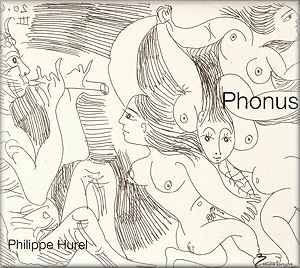 |
 |
|


CD: AmazonUK
|
Philippe HUREL (b. 1955)
Phonus: Phonus ou la voix du Faune (2004) [21:18] ;
Figures libres (2001) [15:43] ; Quatre Variations
(2000) [19:42]
 Benoît Fromanger (flute), Oslo Philharmonic Orchestra/Christian
Eggen; Ensemble Court-Circuit/Pierre-André Valade; Matthew
Ward (percussion); Argento Chambert Ensemble/Michel Galante
Benoît Fromanger (flute), Oslo Philharmonic Orchestra/Christian
Eggen; Ensemble Court-Circuit/Pierre-André Valade; Matthew
Ward (percussion); Argento Chambert Ensemble/Michel Galante
rec. 15 October 2004, Oslo Concert Hall; 3 May 2005, Cité
de la musique, Paris; 8-9 September 2005, Studio Systems 2, Brooklyn,
New York City. DDD
 PLUSLOIN MUSIC PL S217 [56:46]
PLUSLOIN MUSIC PL S217 [56:46] 
|
|
|
The flute concerto Phonus was commissioned
for the Ultima Festival in Oslo, and this recording is the
live recording of the premiere. An atmospheric opening introduces
Hurel’s
spectral style of harmonic writing, with some interesting evolving
textures. The soloist is surrounded by the sound of the orchestra.
An extended cadenza follows, which makes use of numerous contemporary
techniques and is an impressive virtuoso display. Flute player
Benoît Fromanger plays with the utmost technical control
and delivers an exciting and communicative performance. A second
cadenza, which also uses the orchestra’s flute section,
is also highly engaging and forms one of the work’s highlights.
The composition’s subtitle, La voix du Faune makes
reference to the influence of Debussy’s famous orchestral
prelude, with its celebrated opening flute solo, on which Hurel
bases his material. Hurel’s work has a sense of challenge
about it, in terms of its technical demands for the soloist. It
gives a fascinating modern perspective on Debussy’s music,
which permeates this work at every level. There is a sense
of
risk-taking in the performance, providing an appealing sense
of drama, and the playing is always highly convincing, from
both
the soloist and the orchestra.
Figures libres, for eight players, was written in 2001
and commissioned by Ensemble Recherche. The opening possesses
a Stravinskian rhythmic drive, with cells used as the basis
of the work until the players gain freedom, one by one. Virtuosity
once again pervades the music, and combinations of contrapuntal
and monophonic material give variety to the textures. With
three distinct sections, the music builds in momentum before
a sudden change of mood. The central section is slower and
less frenetic, with canons emerging between the parts. The
final section regains the energy of the opening, with repeated
cells once again featuring, and strongly defined rhythmic patterns
maintaining the music’s momentum. Ensemble Court-Circuit
give a virtuosic and impressive performance.
The final work on the disc is Quatre Variations for
percussion and chamber orchestra. The variations of the title
refer to structural and musical parameters rather than a theme
as such; for example, changes are made to interval, rhythms
and tempi. The solo vibraphone gives a wonderful sense of colour,
which is balanced well with Hurel’s imaginative orchestration. Despite the complex structural elements which underlie this work, there is a sense of wit and a lightness of touch which is highly appealing. Gentle jazz influences can be detected, especially in the solo line, and tributes to Grisey and Messiaen also form part of the music’s
material.
Hurel’s music is intelligently constructed and has a sense of unity between all its aspects: orchestration, melody, harmony and structure. There is a strong sense of character in his music and it has much to offer on multiple hearings. The ensembles here are excellent and provide performances of a high quality. The soloists, Benoît
Fromanger and Matthew Ward, are both dazzling and play with
impressive virtuosity and musicianship.
Carla Rees
|
|

